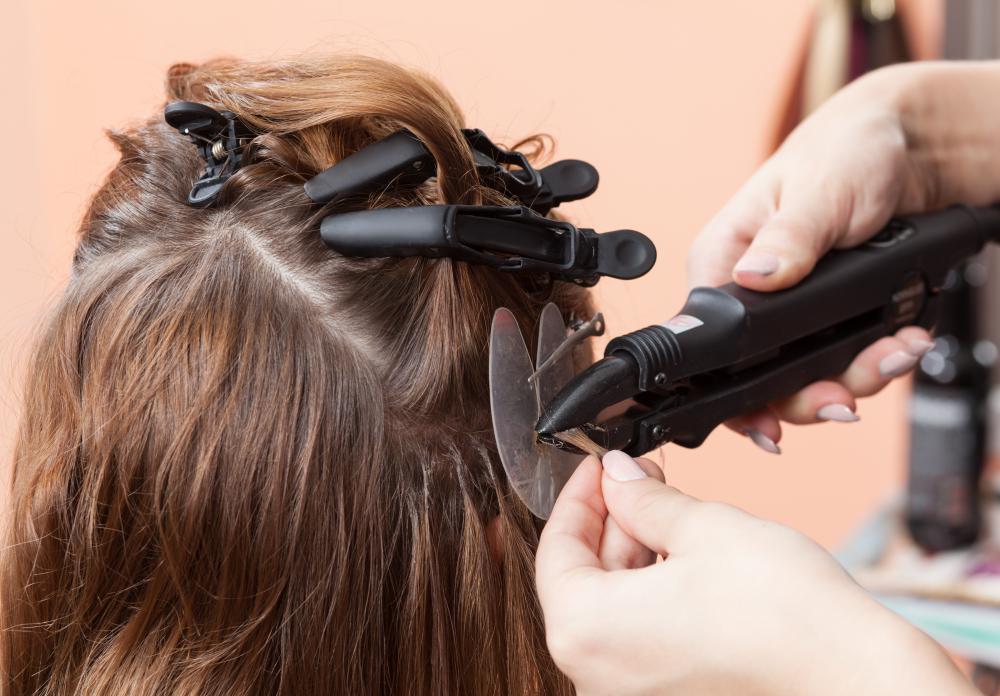At BeautyAnswered, we're committed to delivering accurate, trustworthy information. Our expert-authored content is rigorously fact-checked and sourced from credible authorities. Discover how we uphold the highest standards in providing you with reliable knowledge.
What Is Hair Fusion?
Hair fusion is a technique used to apply hair extensions in order to create a realistic-looking longer hair style. Hair extensions can be attached in a number of different ways, and fusion is usually one of the more permanent. It involves taking sections or strands of natural hair and then bonding them to the extensions in such a way that they appear to be a seamless, natural lock. There are usually three methods used for application, namely hot fusion, cold fusion, and silk protein fusion. Each has its own pros and cons, and different stylists may prefer different methods. In general, the hot method is the strongest and most durable, but also can be the most dangerous as missteps can lead to burns and scalp damage. Cold and protein silk fusion methods tend to be more forgiving, but also might not be as strong or as long-lasting. When applied correctly and cared for appropriately, extensions using any fusion technique should last anywhere from three to six months. A lot depends on the skill and precision with which they were applied, as well as the natural texture, particularly the oiliness, of the natural hair to begin with.
Basic Concept

Extensions are a popular way to change a hairstyle without a lot of effort, and can also allow people to experiment with longer looks without the commitment or upkeep of actually growing hair long. There are usually a number of different styles, from natural looks to colored or highlighted options. Similarly, there are a couple of options when it comes to material. Some are made of natural human or animal hair, whereas others are completely synthetic. No matter the composition, all need to be attached somehow, and fusion is usually one of the most successful and popular methods.

When applying extensions using any of the hair fusion techniques, a section of natural hair and a section of the false hair is matched up and fused together using a specialized hair adhesive. The most natural-looking way of doing this is to use the strand-by-strand method where extensions are applied one small section at a time. For many people, hair fusion extensions are the preferred technique because they can last for months at a time, and they won't normally damage the real hair unlike some other methods. They are also one of the only type of extensions on the market that are completely transparent and virtually undetectable. What this means in practice is that it is usually very difficult for people to see where the extensions are fused to hair even when hair is pulled back or styled in updos.
Hot Fusion

The original, and in most places most popular, process is called hot fusion. Hot fusion involves applying a bonding adhesive to hair and then setting it with heat, often in the form of a small torch or powerful dryer. This method isn't readily recommended for beginners because inexperienced stylists have been known to burn their clients' scalps and cause damage to their natural hair, and as such it shouldn’t normally be attempted at home. Hot fusion may not be as successful with thin or fine hair, either.
Cold Fusion
Cold fusion is an alternative that many salons and even some home stylists use to avoid some of the dangers and risks of heat-centric methods. In cold fusion, a polymer adhesive is applied to the roots of the hair and then secured to the extensions with pressure — but not heat. The process is gentler on hair and there is a much lower risk of damage. A disadvantage of cold fusion is that it can feel awkward and stiff in hair and limit how hair moves, and, when done improperly, can be very noticeable.
Protein Silk Alternatives
Another more advanced hair fusion technique available in many places is called protein silk fusion. Of all the methods available, protein silk fusion is the most gentle on hair. This is because it doesn't require any heat, gluing, or bonding to set it. Instead, a silk protein formula is used to secure the extensions in place. The silk protein adhesive is flexible and will flow nicely with the natural movements of hair so it won't create an unnatural stiff feeling common with the other methods.
AS FEATURED ON:
AS FEATURED ON:













Discussion Comments
Of all the methods you mentioned, Protein Silk is by far the healthiest. I've received them for the past four years and my natural hair has grown from ear length to just past mid back length. I plan to wear them until I"m about waist length and I have African American hair. Prestige Hair Secrets offers this method. That's who I use and I get the Protein Silk Micro method.
Post your comments